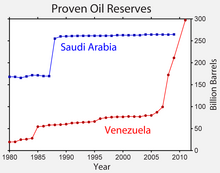Oil reserves in Venezuela

The proven oil reserves in Venezuela are recognized as the largest in the world, totaling 297 billion barrels (4.72×1010 m3) as of 1 January 2014.[1] In early 2011, then-president Hugo Chávez and the Venezuelan government announced that the nation's oil reserves had surpassed that of the previous long-term world leader, Saudi Arabia.[2] OPEC said that Saudi Arabia's reserves stood at 265 billion barrels (4.21×1010 m3) in 2009.[3]
Venezuela's development of its oil reserves has been affected by political unrest in recent years.[when?] In late 2002, nearly half of the workers at the state oil company PDVSA went on strike, after which the company fired 18,000 of them. Venezuela's crude oil is very heavy by international standards, and as a result much of it must be processed by specialized domestic and international refineries. Venezuela continues to be one of the largest suppliers of oil to the United States, sending about 1.4 million barrels per day (220×103 m3/d) to the U.S. Venezuela is also a major oil refiner and the owner of the Citgo gasoline chain.[4]
In October 2007, the Venezuelan government said its proven oil reserves had risen to 100 billion barrels (16×109 m3). The energy and oil ministry said it had certified an additional 12.4 billion barrels (2.0×109 m3) of proven reserves in the country's Faja del Orinoco region.[5] In February 2008, Venezuelan proven oil reserves were 172 billion barrels (27×109 m3).[6]
By 2009, Venezuela reported 211.17 billion barrels (3.3573×1010 m3) of conventional oil reserves, the largest of any country in South America.[7] In 2008, it had net oil exports of 1.189 Mbbl/d (189,000 m3/d) to the United States.[8] As a result of the lack of transparency in the country's accounting, Venezuela's true level of oil production is difficult to determine, but OPEC analysts estimate that it produced around 2.47 Mbbl/d (393,000 m3/d) of oil in 2009, which would give it 234 years of remaining production at current rates.
Orinoco Belt

In addition to conventional oil, Venezuela has oil sands deposits similar in size to those of Canada, and approximately equal to the world's reserves of conventional oil. Venezuela's Orinoco tar sands are less viscous than Canada's Athabasca oil sands – meaning they can be produced by more conventional means – but they are buried too deep to be extracted by surface mining. Estimates of the recoverable reserves of the Orinoco Belt range from 100 billion barrels (16×109 m3) to 270 billion barrels (43×109 m3). In 2009, USGS updated this value to 513 billion barrels (8.16×1010 m3).[9]
According to the United States Geological Survey, the Orinoco Belt alone is estimated to contain 900–1,400 billion barrels (2.2×1011 m3) of heavy crude in proven and unproven deposits.[10] Of this, the United States Geological Survey estimated that 380–652 billion barrels (1.037×1011 m3) could be technically recoverable, which would make Venezuela's total recoverable reserves (proven and unproven) among the largest in the world.[11][12] The technology needed to recover ultra-heavy crude oil, such as in most of the Orinoco Belt, may be much more complex and expensive than that of Saudi Arabia's light oil industry.[2] The USGS did not make any attempt to determine how much oil in the Orinoco Belt is economically recoverable.[9]
References
- ^ BP, Statistical review of world energy Archived June 28, 2015, at the Wayback Machine, June 2014.
- ^ a b Venezuela: Oil reserves surpasses Saudi Arabia's at english.ahram.org.eg
- ^ Venezuela Says Oil Reserves Surpass Saudi Arabia's Reuters at CNBC.
- ^ "Venezuela Oil". Country Analysis Briefs. US Energy Information Administration. 2007. Retrieved 2008-04-27.
- ^ Matthew Walter (2007-10-07). "Venezuela's Proven Oil Reserves Rise to 100 billion barrels (16×109 m3)". Bloomberg. Retrieved 2008-01-05.
- ^ "OPEC Facts and figures". Archived from the original on February 21, 2010. Retrieved 13 March 2010.
{{cite web}}: Unknown parameter|deadurl=ignored (|url-status=suggested) (help) - ^ OPEC data at opec.org
- ^ EIA data at tonto.eia.doe.gov
- ^ a b Christopher J. Schenk; Troy A. Cook; Ronald R. Charpentier; Richard M. Pollastro; Timothy R. Klett; Marilyn E. Tennyson; Mark A. Kirschbaum; Michael E. Brownfield; Janet K. Pitman. (11 January 2010). "An Estimate of Recoverable Heavy Oil Resources of the Orinoco Oil Belt, Venezuela" (PDF). USGS. Retrieved 23 January 2010.
{{cite web}}: Unknown parameter|last-author-amp=ignored (|name-list-style=suggested) (help) - ^ Gonzalez, O., Ernandez, J., Chaban, F., and Bauza, L. (2006). "Screening of suitable exploitation technologies on the Orinoco Oil Belt applying geostatistical methods". World Heavy Oil Conference, Beijing, China November 12–15, 2006 Proceedings. Vol. Paper 2006–774. p. 12.
{{cite book}}: CS1 maint: multiple names: authors list (link) - ^ Schenk C.J., Cook, T.A., Charpentier, R.R., Pollastro, R.M., Klett, T.R., Tennyson, M.E., Kirschbaum, M.A., Brownfield, M.E., and Pitman, J.K. (2009). "An estimate of recoverable heavy oil resources of the Orinoco Oil Belt, Venezuela: U.S. Geological Survey Fact Sheet 2009–3028".
{{cite web}}: CS1 maint: multiple names: authors list (link) - ^ Venezuela oil 'may double Saudi Arabia' BBC

